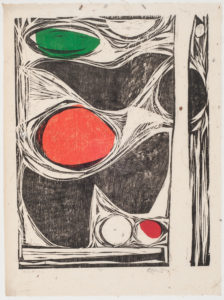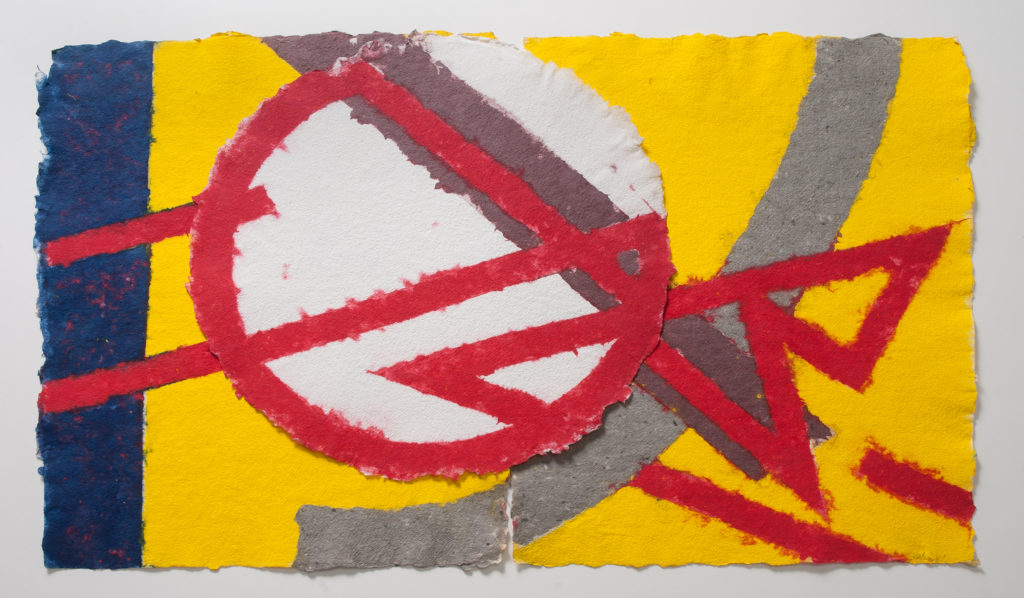Many have dreamed of far-flung adventures or pursuing a career as an artist, but few actually do it. Clinton Hill managed to do both as well as serving as a commanding officer in the U.S. Navy and helping to build the art scene in New York’s SoHo. Now the Georgia Museum of Art at the University of Georgia is presenting an innovatively installed exhibition of his work from throughout his career. The museum’s director, William U. Eiland, is its curator and the author of its accompanying exhibition catalog.
Born in Payette, Idaho, and raised on a ranch near several American Indian settlements, Hill grew to appreciate nature and vast spaces. He also learned to admire Native American culture—his first exposure to any culture outside of his own. He craved exploration and a greater understanding of the world, which led him to travel abroad in the hope of furthering his arts education.
When Hill’s family moved to La Grande, Oregon, he began working with watercolor and eventually found his vocation as an artist. When World War II broke out, he volunteered for the U.S. Navy and soon became a commanding officer of a minesweeper stationed in the Pacific. The military gave Hill a sense of confidence and the drive to pursue art as a career. It also introduced him to Allen Tran, his life partner and traveling companion. After the war, Hill studied art at the University of Oregon on the GI Bill before moving to New York with Tran at an exciting time for abstraction. New York was becoming the capital of the art world, and abstraction—which Hill would pursue for the rest of his life—was the movement of the day.
Hill continued to travel, studying in Paris, France, in 1951 at the Académie de la Grande Chaumière, then in Florence, Italy, at the Istituto d’Arte Statale. When he and Tran returned to New York, Hill had a series of high-profile solo shows and established himself more firmly in the art scene. The famed abstract expressionist Mark Rothko even helped name one of Hill’s most significant works, “Ladders and Windows.”

Clinton Hill (American, 1922–2003), untitled, 1960. Woodcut on paper. Georgia Museum of Art, University of Georgia; Gift from the Clinton Hill / Allen Tran Foundation. GMOA 2012.377.
Hill pushed his work beyond paint, using wood, paper and vinyl as well as other materials. Paper was especially recurrent, and he crafted subtle, complex, layered works from paper pulp and torn pieces of paper in the 1960s. Minimalist, with evocative colors, they look forward to the abstract yet imagistic art of the 1980s. Hill never stopped exploring different cultures and incorporating what he learned into his art. In 1956, he traveled to India on a Fulbright Fellowship, where he learned ancient methods of weaving and papermaking. When he returned home, he began to integrate a variety of different materials into his art. From fiberglass to discarded construction debris, Hill was able to make structured works that reflected his skills as both a sculptor and abstract artist.
Eiland and the museum’s preparators designed an exhibition that would make connections among works from throughout Hill’s career. Paintings hang at unusual heights to suggest musical notes on a staff (music was another theme that recurred in Hill’s work) or to make the viewer connect visual elements in different works. Lightboxes on the floor show the layered nature of Hill’s works with paper, and jewelry he made from radio resistors is included alongside more traditional fine art.
“The exhibition of Clinton Hill’s works presents to our audiences an artist, relatively unknown in our region, who is in some ways emblematic of the various ‘isms’ of the mid-to-late 20th century,” said Eiland. “A colorist and formalist, he becomes in mid-career one of the pulp-paper pioneers, an artist who reimagined the very material of his art. Second, the installation itself is an homage to Hill’s marriage of plane and solid geometry; the arrangement of the works in the galleries delivers a series of visual puns arising from the artist’s abiding themes of music, harmonics and the movement of forms in space.”
“Clinton Hill” is on view through March 18 at the museum and is generously sponsored by the Clinton Hill/Allen Tran Foundation, the W. Newton Morris Charitable Foundation and the Friends of the Georgia Museum of Art. Programs related to the exhibition include 90 Carlton: Winter, the museum’s quarterly reception on Feb. 1 at 5:30 p.m.
Museum Information
Partial support for the exhibitions and programs at the Georgia Museum of Art is provided by the Georgia Council for the Arts through the appropriations of the Georgia General Assembly. The Georgia Council for the Arts also receives support from its partner agency, the National Endowment for the Arts. Individuals, foundations and corporations provide additional museum support through their gifts to the University of Georgia Foundation. The Georgia Museum of Art is located in the Performing and Visual Arts Complex on the East Campus of the University of Georgia. The address is 90 Carlton St., University of Georgia, Athens, Ga. 30602-1502. More information is available online or by phone at 706-542-4662.
